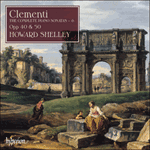
Welcome to Hyperion Records, a British classical label devoted to presenting high-quality recordings of music of all styles and from all periods from the twelfth century to the twenty-first.
Hyperion offers both CDs, and downloads in a number of formats. The site is also available in several languages.
Please use the dropdown buttons to set your preferred options, or use the checkbox to accept the defaults.

| Howard Shelley (piano)» More |
The Adagio con molto espressione in D minor that follows is something of a compromise between a proper slow movement and (recalling the B minor sonata of this set) an extended slow introduction to the finale. Its opening theme, one of several distinct kinds of material Clementi offers us, imitates the elegant shape and rhythmic ambiguity of the opening theme of his earlier sonata in A major, Op 33 No 1. Then comes the finale, a bright, cheerful rondo whose central episode in D minor is mainly a canon (one of Clementi’s best) based on that opening theme.
from notes by Leon Plantinga © 2010
L’Adagio con molto espressione en ré mineur suivant tient du compromis entre un mouvement lent proprement dit et (écho de la sonate en si mineur de ce corpus) une vaste introduction lente au finale. Son thème inaugural, l’un des matériaux distinctifs proposés par Clementi, imite la forme élégante et l’ambiguïté rythmique de son pendant dans la sonate en la majeur op. 33 no 1, antérieure. Le finale qui vient ensuite est un rondo éclatant et enjoué, dont l’épisode central en ré mineur est avant tout un canon (l’un des meilleurs de Clementi) fondé sur ce thème inaugural.
extrait des notes rédigées par Leon Plantinga © 2010
Français: Hypérion
Das folgende Adagio con molto espressione in d-Moll ist eine Art Kompromiss zwischen einem eigentlichen langsamen Satz und (wie in der Sonate in h-Moll in dieser Einspielung) einer erweiterten langsamen Einleitung zum Finale. Mit dem eröffnenden Thema, einem von mehreren mit unterschiedlichem Material, imitiert Clementi die elegante Form und die rhythmische Mehrdeutigkeit des Eröffnungsthemas seiner früheren Sonate in A-Dur, op. 33 Nr. 1. Dann folgt das Finale in Gestalt eines hellen, fröhlichen Rondos, dessen Mittelteil in d-Moll überwiegend ein (zu Clementis besten zählender) Kanon auf Grundlage dieses eröffnenden Themas ist.
aus dem Begleittext von Leon Plantinga © 2010
Deutsch: Henning Weber
 Clementi: The Complete Piano Sonatas, Vol. 6 Clementi: The Complete Piano Sonatas, Vol. 6Howard Shelley’s series of Clementi’s Piano Sonatas has received the highest critical acclaim and reawoken interest in this important body of piano music. This sixth and final volume contains some of the most complex, virtuosic and large-scale wor ...» More |

